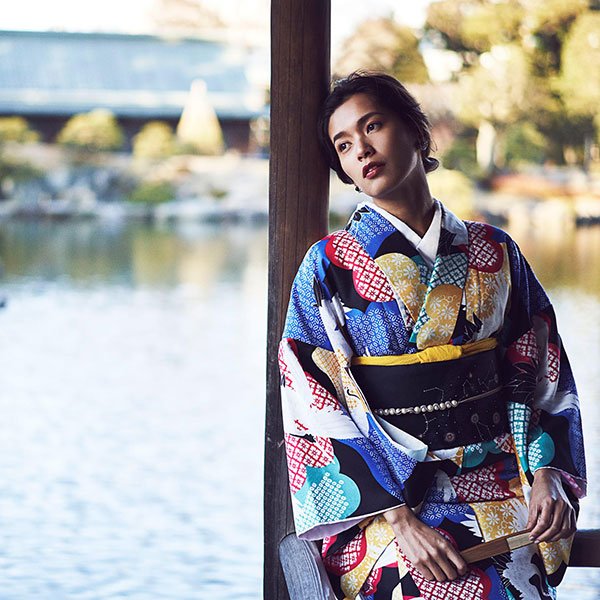5 Things You Should Know About Yuzen Kimono
by Lucy Dayman | CRAFT
© Chiso Kimono, Kyo-Yuzen Furisode Kimono
The kimono is unmistakeably one of the most iconic tangible pieces of Japanese culture. Like many Japanese arts, the original incarnation of the kimono was inspired by Chinese fashion, but over the centuries it evolved into something distinctly Japanese.
Yuzen dyeing is precisely what made kimonos extraordinary. Arising from the rich tradition of Japanese painting, yuzen dyed kimonos embody the unique category of wearable art – they are not merely clothing and they’re not simply a canvas: they’re something wholly separate, the blurred line where life and art collide.
Read on to explore the world of yuzen kimono. We will uncover its fascinating history and styles, the master artisans you should know, and the best places in Japan where you will be able to experience yuzen dyeing techniques, and try one on for yourself!
You don’t have to be in Japan to enjoy kimono fashion! Wherever you are in the world, you can shop for authentic Japanese kimono and yukata at the Japan Objects Store.
1. What is a Yuzen Kimono?
Autumn, Woodblock Print by Tomimaro Higuchi, 1946
The term yuzen is named for the legendary Kyoto-based artist Miyazaki Yuzen Sai (1650-1736), who was a lauded fan painter and the man who came up with the original techniques still seen in traditional kimono dying today. It wasn’t (and still isn’t) uncommon for Japanese painters to transfer their talents from their usual mediums, be they fans, canvas or tapestries, and apply them to kimono painting.
2. How To Do Yuzen Dyeing?
© Kaga Yuzen Kimono Center, Initial Pattern
The original yuzen process used stencils to transfer a design onto fabric, and starch (known as nori) onto the fabric to allow colors to be added layer by layer.
The first version of the image is initially sketched directly onto the fabric. The starch (nori) is applied to areas of the pattern that are to remain undyed. The nori acts as a boundary for the ink, protecting the untouched fabric from the dye. After the initial coloring has been done, a dye resistant starch known as fusenori is spread over the dyed area. The kimono’s base color is then dyed, while the covered area remains protected by the fusenori.
© Kaga Yuzen Kimono Center, Painting Kimono
Following these steps, yuzen kimonos can be customised to suit requests, so say for example you’re looking for a little extra old-world Kyoto style flare like gold leaf (which we’ll speak further about later), you can add it once the process it finished. The entire process can take upwards of a month.
Crafted over centuries ago, the technique has been tweaked and appropriated by other cultures outside of Kyoto and even Japan. Companies have found ways to automate the process, while in Okinawa local artisans created bingata a slightly different technique (used on fabrics beyond the kimono) that is said to have been crafted sometime in the 14th century, predating the creation of yuzen dyeing.
To find out more about the different styles and patterns in kimono design, check out The Art of Kimono: Designs, Patterns and Inspiration!
3. What are the Different Styles of Yuzen Kimono?
© Chiso Kimono, Kyo-Yuzen Furisode Kimono
Kyo-Yuzen: It’s best to begin with what is arguably the original, Kyo yuzen which as you probably guessed hails from Miyazaki Yuzen Sai’s home city of Kyoto. Created for the higher echelons of society, such as members of the imperial court, Kyo yuzen is all about showing off the finer things in life. Typical Kyo yuzen designs can be spotted by their intricate patterns, which are not afraid to incorporate elaborate silver and gold leaf embroidery into their design.
As it relies on a wide spectrum of colors, creating Kyo yuzen garments requires a large number of steps. Typically there was a different artisan assigned to each step of the process. In terms of other distinctive characteristics, another way to identify Kyo yuzen is to take a look at the color gradation of the flower petals. If they begin darker in the centre and get lighter towards the outside of the petal, there’s a good chance it could be a Kyo yuzen kimono.
Kyo-yuzen techniques are also used to produce exquisite silk fabrics for other items. The elegant silk clutch above, handcrafted in Kyoto by Tomoko Fujii of RITOFU, showcases this artful blend of Japanese tradition and contemporary fashion, available from Japan Objects Store, with free shipping worldwide!
© Kaga Yuzen Kimono Center, Kimono by Akehito Inade
Kaga-Yuzen: Originating in the arts-centric city of Kanazawa comes Kaga yuzen, a style which gets its name from the Kaga clan of Ishikawa Prefecture in which it evolved. The history books say that Miyazaki Yuzen Sai brought his technique to Kanazawa himself, however over time the style morphed into something a little different to its predecessor. On many Kaga yuzen kimono you may notice a recreation of a less than perfect leaf, maybe one that’s been bitten by an insect. This imagery is known as mushi-kui which translates to insect bitten. It’s a conscious artistic decision said to represent the transience of nature.
© Kaga Yuzen Kimono Center, Kimono by Kenji Maida
One of the main ways to differentiate the two styles are the flower shading and use of gold and silver leaf. Kaga yuzen tends to avoid using gold and silver leaf for a slightly more understated approach to design. Remember the flower graditation on the Kyo style? From dark in the centre to light at the ends? Well Kaga style gradation goes the opposite, from dark on the outside to light in the centre.
© Nakamura Katsuma, Edo-Yuzen
Edo-Yuzen: Born in Japan’s largest, the Tokyo version of yuzen was more inspired by sleek practicality than it was by over-the-top showmanship. You can easily identify a Edo or Tokyo yuzen by its more muted, softer color palette which often plays backdrop to images of Edo-era merchants at work. As this style was evolving, the city was under the rule of a strict sumptuary law which forbade people from any over displays of luxury and extravagance.
An embodiment of the time of its creation, the ethos of Tokyo yuzen can still be seen today in the city’s everyday attire; generally understated but undeniably stylish. If you’re looking to buy a kimono for yourself while in Tokyo, you should take a look at these 9 Best Stores to Buy Kimono in Tokyo!
4. Where Can You Find Yuzen Kimono in Kyoto?
© Chiso Kimono, Yuzen Patterns
Chiso: Is one of the most established and respected homes of the kimono in Kyoto. The brand was originally established in 1955 and since its inception has continued to make, sell and display some of the most exquisite kimonos in the country. Guests are welcome to visit and simply admire the 20,000 piece collection on display, or if they’re feeling so inspired, request a custom made gown.
Address: 80 Mikuracho, Nakagyo-ku, Kyoto
Website: chiso.co.jp
Marumasu-Nishimuraya: If just looking isn’t enough and you really want to get hands on by partaking in a kyo-yuzen kimono making workshop, then book a visit to Marumasu-Nishimuraya, in the center of Kyoto city to sign up for one of their comprehensive workshops. During the workshop guests can select from a number of different articles on which to try the Kyo yuzen dyeing techniques including handkerchiefs and tapestries.
Address: 457 Tsuboya-cho, Ogawa-dori, Oike-sagaru, Nakagyo-ku, Kyoto
Website: marumasu-nishimuraya.co.jp
For some more ideas for kimono shopping in Kyoto, check out these 5 Best Places to Buy Kimono in Kyoto!
5. Where Can You Experience Yuzen Dyeing in Kanazawa?
© Kaga Yuzen Kimono Center, Have a Go Yourself!
Kaga Yuzen Kimono Center: To learn all there is to know about Kaga kimono, it’s best to make your way to Kaga Yuzen Kimono Center in Kanazawa. Generally open from 9am until 5pm every day except Wednesday and some selected public holidays, the center welcomes guests to come and try both kimono dying and kimono fitting. Here for ¥2,000 ($18) you can try on a kimono (professionally fitted by local experts) and for ¥4,500 ($40) go strolling in the historic neighbourhood fully dressed in a classic Kaga style kimono. For those more interested in the dying process you can sign up for a Yuzen-dyeing class handkerchief where you’ll create your own piece on a handkerchief for less than ¥1,600 ($15).
Address: 8-8 Koshomachi, Kanazawa
Website: kagayuzen.or.jp


















ART | October 6, 2023